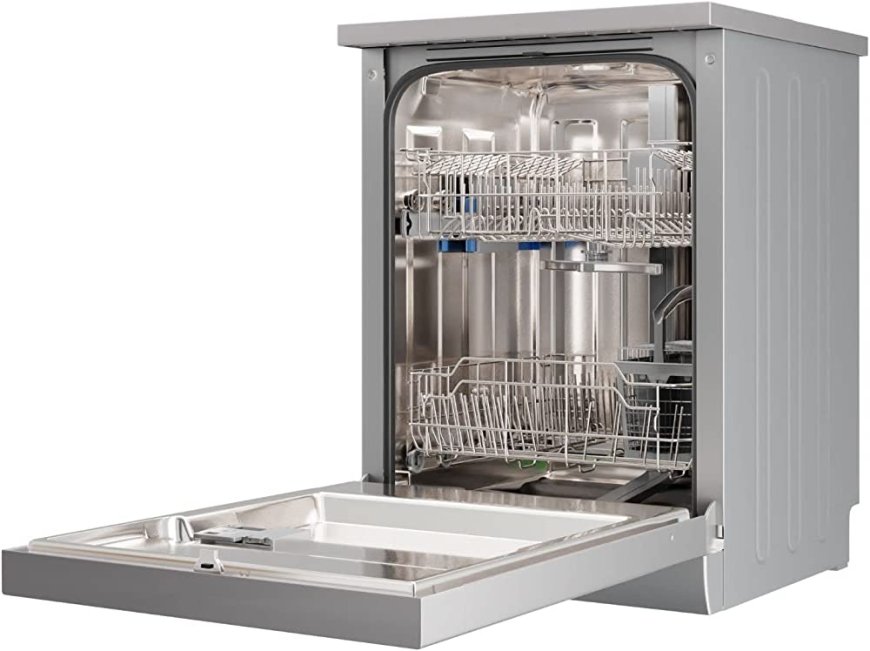Dishwasher - Features and How to use

Dishwasher :
A dishwasher is a household appliance designed to clean and sanitize dishes, cutlery, and other kitchen utensils. It automates the process of washing dishes, making it more convenient and time-efficient than washing them by hand. Dishwashers are typically installed under kitchen countertops and connected to a water supply and drain system.
To use a dishwasher, you load dirty dishes into racks or baskets within the machine. The dishwasher then sprays hot water mixed with detergent onto the dishes, removing food particles, grease, and stains. Some dishwashers have additional features like pre-wash cycles, sanitize options, and adjustable wash settings to accommodate different types of dishes and cleaning requirements.
Once the cleaning cycle is complete, the dishwasher drains the dirty water and may rinse the dishes with fresh water. Some dishwashers also have a drying feature, which can use heat or a fan to dry the dishes. Afterward, you can unload the clean and dry dishes from the dishwasher.
Features : Dishwashers come with a variety of features and options that can enhance their functionality and efficiency. Here are some common features you may find in modern dishwashers:
Multiple Wash Cycles: Dishwashers offer different wash cycles to accommodate various types of dishes and levels of dirtiness. Some common cycles include normal, heavy-duty, light, quick wash, eco-friendly, and sanitize.
Delay Start: This feature allows you to set a specific time for the dishwasher to start the wash cycle. It can be useful if you want to take advantage of off-peak electricity hours or have the dishes ready at a specific time.
Adjustable Racks and Tines: Dishwashers often come with adjustable racks and tines, which allow you to configure the interior space to accommodate dishes of different sizes and shapes. You can lower or raise the racks and fold down or adjust the tines to create more room or secure delicate items.
Half Load Option: Some dishwashers have a half load or a zone wash feature, enabling you to wash only the top or bottom rack when you have fewer dishes to clean. It can save water, energy, and detergent.
Soil Sensors: Dishwashers with soil sensors automatically detect the level of dirtiness in the water and adjust the wash cycle duration and intensity accordingly. This feature helps optimize water and energy usage.
Child Lock: A child lock feature prevents children from accidentally opening the dishwasher or tampering with the controls, ensuring their safety.
Energy Efficiency: Look for dishwashers with an ENERGY STAR certification, as they meet specific energy efficiency guidelines and can help reduce energy consumption and utility bills.
Sound Insulation: Some dishwashers come with added insulation or special sound-reducing features to minimize noise during operation. This can be especially beneficial if your kitchen is close to living areas or bedrooms.
Smart Connectivity: Certain models offer smart features, allowing you to control and monitor your dishwasher remotely using a smartphone app. You can start or stop cycles, receive notifications, and even integrate with voice assistants for hands-free operation.
How to Use:
To use a dishwasher, follow these general steps:
Preparing the dishwasher: Ensure that the dishwasher is properly installed, connected to the water supply, and plugged into a power outlet. Make sure the dishwasher is empty and all items that are not dishwasher-safe, such as wooden utensils or delicate glassware, are removed.
Scraping off excess food: Before loading the dishes, scrape off any large food particles from plates, bowls, and utensils. You don't need to pre-rinse the dishes, as modern dishwashers are designed to handle food residue.
Loading the dishwasher: Place larger items, such as pots and pans, on the lower rack. Plates, bowls, and cookware should face inward to allow water and detergent to reach all surfaces. Glasses, cups, and smaller items can be placed on the upper rack, ensuring they are secure and not touching each other. Silverware can go in a separate utensil basket or tray, or you can use the designated silverware slots in the dishwasher racks.
Adding detergent: Consult your dishwasher's user manual to determine the appropriate amount and type of dishwasher detergent to use. Typically, dishwasher detergents come in gel, powder, or tablet form. Add the detergent to the designated dispenser in the dishwasher, following the manufacturer's instructions.
Selecting wash options: Depending on your dishwasher model, you may have various wash cycle options. Choose the appropriate cycle based on the level of dirtiness and the type of dishes being washed. You may also have additional options such as temperature settings, sanitize mode, or eco-friendly mode. Adjust these settings as desired.
Starting the dishwasher: Close the dishwasher door securely and select the desired options on the control panel. Some dishwashers have a delay start feature if you want the cycle to begin at a later time. Press the start button or turn the cycle dial to initiate the wash cycle.
Unloading the dishwasher: Once the dishwasher completes the wash cycle, it may indicate its completion through a beep, a display message, or an LED indicator. Open the dishwasher carefully, as dishes may still be hot. Start unloading the dishes from the bottom rack first, as they tend to be cooler. Leave the door slightly ajar for a short period to allow any remaining moisture to evaporate.
What's Your Reaction?



















































